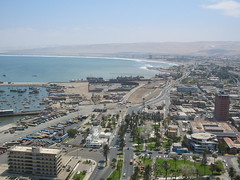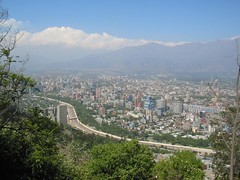From Antofagasta all roads lead into the heart of the Atacama desert, a trip to a mysterious abyss. Crossing the desert by bus, on foot and partly by bicycle, you come into contact with an incredibly dry earth, a lunar landscape wrought by a tropical and breath taking sun. Even here a few brave people still live, especially because the barren land hides an incredible richness of the subsoil. Along the way are oases of dust and 60 years old american cars, mining towns were abandoned to their infamous faith, swallowed by the sand and the passing of time. Pedro de Valdivia, Maria Elena, and then Quillagua.
The red earth hides, together with the minerals, the countless bodies of those who have come here to die by their own choice (open copper mine of Chuquicamata is the largest in the world), and many by constraint (the Pinochet’s regime jailed in these wastelands dissidents for forced labor). A lasting memory of these tragedies are the graves of Pisagua. The memory of these abuses spread the devotion to Saint Lawrence, considered by Chileans as the patron of the miners and celebrated on August 12 of each year. He hid the material goods of the church under the ground to protect them from the voracity of the Emperor Valerian. Similarly, the Chileans are struggling to maintain control over their natural resources (gold, silver, nickel, molybdenum, sulfur, etc..).
Maria Elena is a town hanging in the wind, the presence of ghosts fills the void of a community hidden underground. Everything disappears in the heat of the afternoon, but even in the evening when the heat loosens its grip, the community does not come alive. The resignation of a life of hardship covered with dusty scrub every house, every object. We stop at a playground where the swings have died of rust and neglect, each mechanism creaks, the children have left these amusements even before their birth.
Where the atacama desert begins
The landscape, a few hours north of Santiago de Chile, slowly begins to change. There appear the first signs of the Atacama Desert, which occupies a huge part of the north of Chile. Chañaral is a town that lies on the Pacific coast where the border between the sea and the desert begins to be clear. Don Hugo was an indefatigable man of the sea, which at maturity has invented an innovative way to survive and at the same time to provide jobs for many of his fellow citizens, just taking advantage of the particular climatic conditions of the Chilean coast. In fact, in Chañaral drought begins to be a problem, but the high temperature range between day and night, the proximity to the ocean and the conformation of the hilly area, make possible that every morning on the city passes a thick blanket of wet fog. Don Hugo has invented a system of sheets that trap moisture and cause it to condense into water. An ingenious system of collection, channeling, and depressurization of the liquid allows to transport the water 800 meters down the hill, where there are some houses and plantations. Each day the system is able to generate about 5000 liters of drinking water. On the night we head to Antofagasta, the last big city before entering the desert, and finally in the region of Chilean mines. Father Hurtado, a well known Jesuit saint, a practical and hard worker man friend of working people and Chilean miners, watches over this underwater world.
Santiago de Chile: poetry, recycling, arts
Santiago de Chile, a small hotel for travelers run by an indigenous Mapuche, skyscrapers and crumbling houses. From the hill overlooking the city, as a kind of ordeal, you can enjoy a 360 degree view of the capital city, long and endless. Sometimes hidden behind the clouds, the Andes are majestic and snow-capped, in the background you can see the white paradise of Tres Valles and Valle Nevado, the ski resorts that are located only 50 kilometers from Santiago de Chile. The bustling center takes attention away from the phenomena of creative and marginalized life of the vast majority of the population. In the north of Santiago is located a huge landfill where most of the waste of the city is collected. The people who live there have earned the nickname of moscas, in the evocative dialect of Chile. They brave daily fortune, rising with great agility on each garbage truck that arrives at the landfill and they recover valuable pieces such as iron, copper, aluminum, bicycles and any material that can then be recycled or sold on the black market. Another example of creative adaptation is represented here by Don Ignacio, an intelligent man of about fifty years, who completely dedicated to retrieve pieces of wood, glass and metal at the landfill over the last twenty ones. His only goal, brilliantly achieved, was to build a abusive house with the scraps, equipped with every comfort and a strong and personal sense of aesthetics. The city is alive and looks at arts and poetry. The birth of the murales in Chile as a mass phenomenon, dates back to the 1969, at the time of protests against the Vietnam war, From the port of Valparaíso to Santiago de Chile, a few guys repainted the entire pathway of the protests by stopping at each rock along the road with an old Jeep. The Chilean group of murales is called the brigadas Ramona Parra and was born with the aim of achieving the candidacy of Salvador Allende in the propaganda of 1970. The urban murales are made of symbols and letters. The dove, hands, ears, the stars were a new language that has long been popular in the underground of the night.
Through the window Brazil, Argentina, Chile
From the airplane window, a long prelude begins when breaking the monotonous blue line of the ocean appears the sensual green and gold shape of Brazil, an outpost of the South American continent. It will be like a tape rewind live in the future, when we will be immersed in the journey. Dazzle the eyes observing these endless lands. The plane heads quickly towards the south, the colors of the austral spring appear where the Rio de la Plata hugely plunges into the Atlantic Ocean, separating Uruguay from the big sister Argentina. Buenos Aires appears, boundless. Underfoot the ground is dry and disconnected, rising announces the show of the Andes, the amazing mountain range that divides Argentina and Chile The shape of Aconcagua, the highest peak in America with its 6962 meters (22,841 feet) above sea level, hides the sun, but not the first glimpses of bucolic valleys of central Chile, surrounded by the first spring blooms. Further on, the Pacific Ocean rests agitated by powerful waves like mountains.
Santiago de Chile looks like a long strip that stretches from north to south, sometimes unformed, a small copy of the entire Chile, with its characteristic threadlike shape. So deeply varied and contradictory. Santiago is alive and pulsating.


